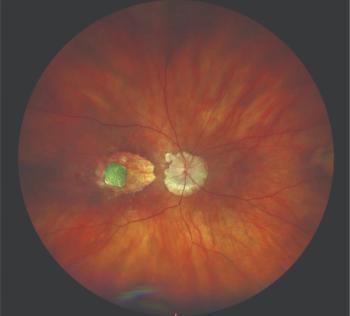
App offers personal risk profile for diabetic retinopathy
Tool is empowering patients to understand disease, become more involved in their treatment.
For patients with diabetes, accessing the risk for the development of diabetic eye disease may be at their fingertips with a new app (Retina Risk App,
“This mobile app should empower patients to better understand their own risk profiles for eye disease and motivate them to modify their personal risk factors,” Einar Stefánsson, MD, PhD, emphasized.
The availability and importance of a tool such as the app is underscored by how pervasive diabetes has become, said Dr. Stefánsson, professor of ophthalmology and physiology,
“The global diabetes epidemic has tripled since 2000, to some 430 million persons worldwide, and is expected to exceed 600 million by 2045,” he noted. “Two-thirds of persons with diabetes develop diabetic retinopathy and one-third develop sight-threatening diabetic retinopathy over 20 years. These patients are at high risk of visual impairment or even blindness if not diagnosed and treated in a timely manner.”
Routine eye screenings and preventive treatment may reduce instances of blindness that can develop as a result of diabetes, which is where the app comes into play.
RELATED CONTENT:
Clinically validated
Dr. Stefánsson and Arna Gudmundsdottir, MD, co-founders of RMS, pointed out that the app is a clinically validated risk calculator that allows people with diabetes to assess in real-time their individualized risk for development of sight-threatening diabetic retinopathy, based on their risk profile.
According to the physicians, the app includes detailed guidelines and useful information on diabetes, diabetic retinopathy, and improved self-care, and helps patients to better understand their condition and become active participants in their own wellness journey.
Dr. Gudmundsdottir is a diabetologist at
Key features of app
Features include individualized and free risk assessment for diabetic retinopathy; customized, easily understandable information with clear guidelines; patient educational material that improves diabetes management and quality of life; ability to track progress; ability to export and share results; and goal setting.
A major characteristic of the app is that it empowers patients with diabetes to become more involved in their healthcare decision-making. This fits very well with the latest American Diabetic Association/European Association for the Study of Diabetes consensus guidelines on management of hyperglycemia that have a special emphasis on patient-centered care and shared decision-making.
It supports patient self-management by demonstrating the importance of regular eye examinations and seeking timely medical assistance. It motivates patients to become more responsible and better informed. Its educational tools demonstrate how the improvement of modifiable risk factors, such as blood glucose, hemoglobin A1c, and blood pressure, can significantly lower the risk of serious diabetic eye disease and expensive interventions, Drs. Stefánsson and Gudmundsdottir pointed out.
The app algorithm
The proprietary algorithm used in the app was validated clinically in 20,000 persons with diabetes and the results published in several medical journals that are accessible on the app website.
The algorithm calculates patients’ annualized risk of developing sight-threatening diabetic retinopathy based upon major, well-established risk factors for the development of diabetic retinopathy.
The algorithm was validated clinically in Northern European diabetes cohorts, which include a variety of races and ethnicities. Future validation in other populations is planned.
The investigators explained that the processes implicated in sight-threatening diabetic retinopathy in all populations depend predominantly on metrics in the algorithm that include blood glucose control and status, blood pressure, disease duration, gender, diabetes subtype, and the presence or absence of non-proliferative retinopathy.
While the algorithm accounts for 80% of established risk in patients with diabetes based upon a preponderance of research data, there are other emerging factors, including obstructive sleep apnea, obesity, and a history of other diabetes complications that probably account for some of the remaining risk and may very well be important for refinement of predictive power. More detailed analysis of the fundus image, for example, with artificial intelligence and the addition of oximetry is likely to increase the power of the personal prediction from the current 80% to well over 90%.
“The personalized report form generated for each patient should allow health care providers to communicate the presence of at least some of these emerging risk factors and recommend additional preventative strategies for patients based upon clinical judgment and new research findings,” Dr. Stefánsson explained.
The app also answers frequently asked questions that help educate patients about their diabetes and diabetic retinopathy and a blog.
“Our vision is to improve diabetes care and transform diabetes education and care by applying technology and epidemiologic data to improve outcomes, focus on patients at the highest risk, and save money. This is mobile, digital health at the user’s’ fingertips,” Dr. Stefánsson concluded.
Disclosures:
Einar Stefánsson, MD, PhD
E: [email protected]
Dr. Stefánsson cofounded RMS in 2009.
Arna Gudmundsdottir, MD
E: [email protected]
Dr. Gudmundsdottir cofounded RMS in 2009.
Newsletter
Don’t miss out—get Ophthalmology Times updates on the latest clinical advancements and expert interviews, straight to your inbox.





